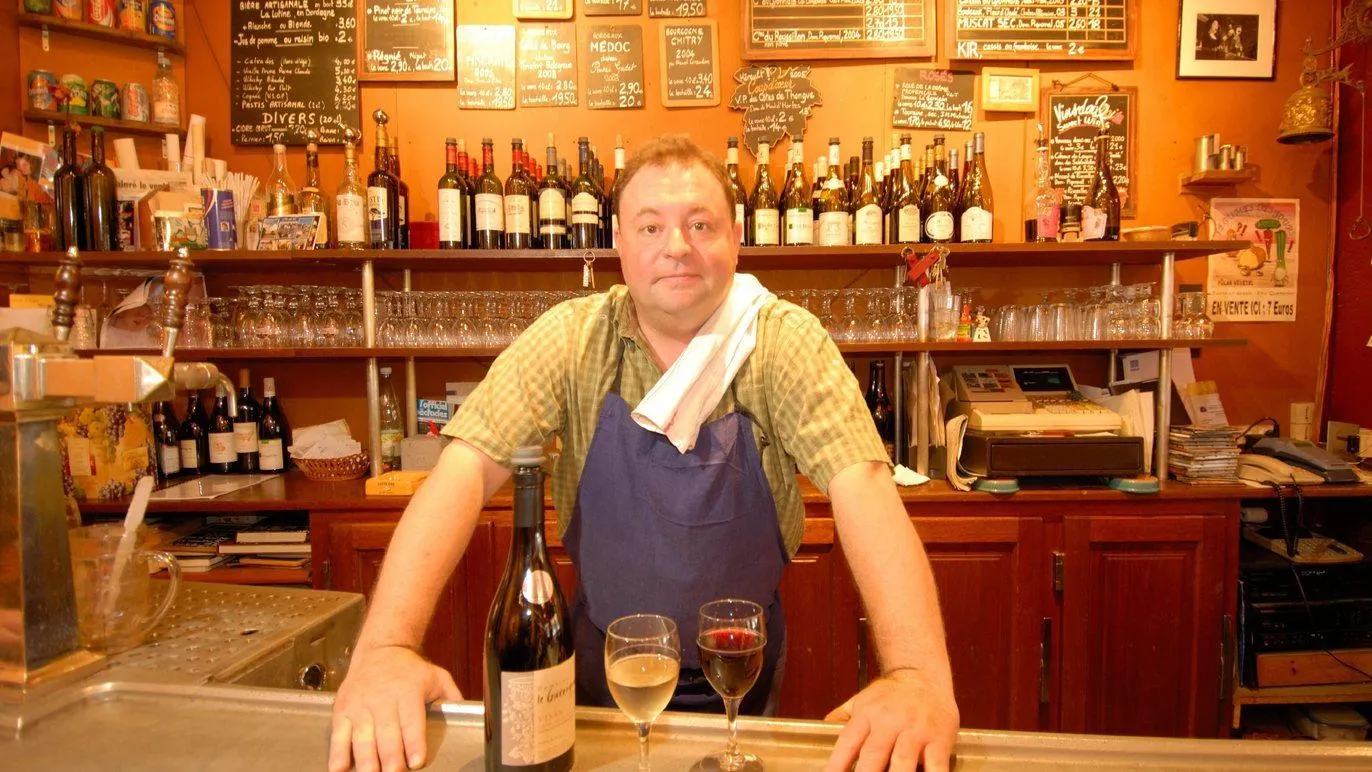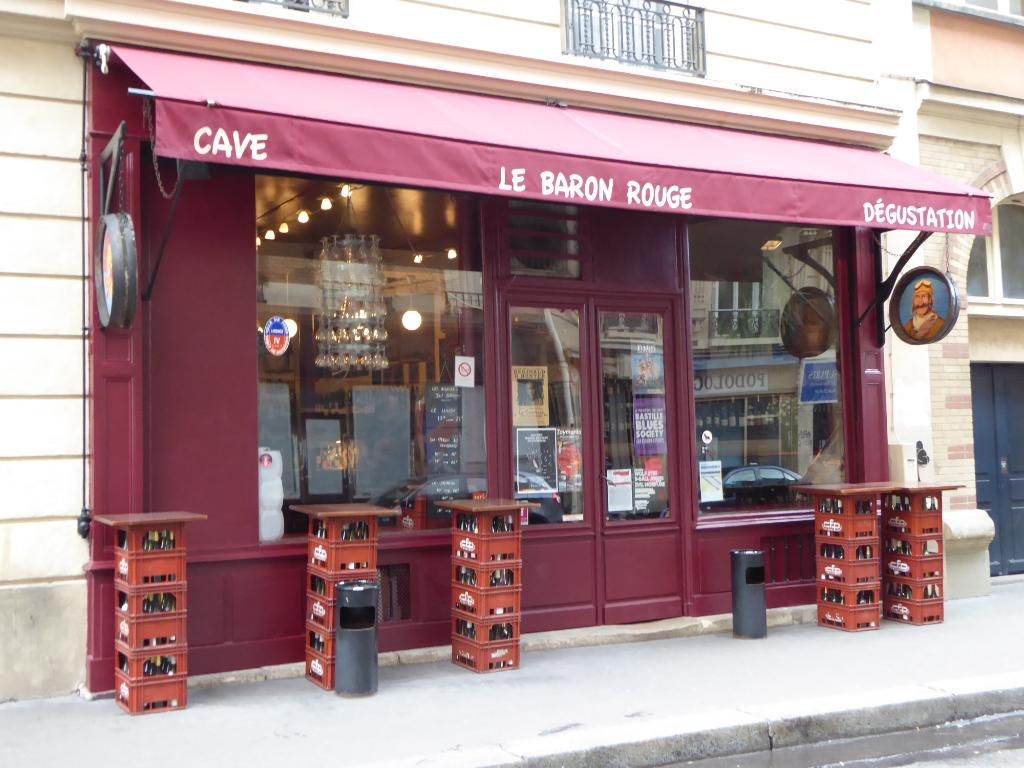
It is fair to say that the Baron Rouge changed the way I think about how a public space can and should be used. Before discovering Le Baron Rouge, I had never been in a place that spent so little time making guests physically comfortable or paying attention to the rules, but was so perfectly fitted to the life of its neighborhood. But that is getting ahead of myself.
Le Baron Rouge first entered my conscientiousness by chance, on a Sunday afternoon, when we happened past it during a stay in Paris. Back in the 1990’s, our favorite Paris neighborhood was near the Place d’Aligre, on the border between the 11eme and 12eme arrondissement. We always stayed in the (long vanished) Résidence Trousseau, a hotel named after the nearby Square Trousseau. Heading back to the hotel one fall Sunday afternoon, we were surprised to see a big crowd of people filling the sidewalk of rue Théophile Roussel. The nearby street market at place Aligre had already closed for the day and the rest of the neighborhood was settling into its Sunday afternoon torpor, as people headed home for the traditional Sunday afternoon family supper. But here was a boisterous, happy mob, spilling out between the parked cars and into the street. What is this place?
Pushing up through the crowd, we discovered Le Baron Rouge for the first time. Behind its cheerful red storefront, a tiny space, one wall lined with wine barrels, the other with a tiny zinc bar, and one corner filled with five tightly packed tables. Behind the bar, the wall is covered with small chalkboards listing the (seemingly vast) selection of wines. A few wine barrels are scattered around as a place to put your glass of wine. Toward the back, a tiny kitchen space, maybe 6’x6′, from which emerge plates loaded with charcuterie or runny St-Félicien cheeses. And everywhere, elbow to elbow and shoulder to shoulder, neighborhood denizens, happily raising a glass to celebrate the fact that it is Sunday and one doesn’t have other obligations.
Ordering is a bit of a struggle: there is no neat order for approaching the bar, you just push forward. When you get to the bar, the service team is friendly but in a hurry and, therefore, would appreciate you having a ready idea of what you want to order – if you want to chat about the qualities of the wines they offer, show up during off hours, when time is not at a premium. The Beaujolais is chilled, the charcuterie is excellent (especially the smoked andouille sausage from Normandy), you find a little corner to put your plate down and life is good.
The toilets at Le Baron Rouge are also a bit daunting. Access to them is through a small door on one side of the kitchen, so you almost feel you are intruding to go that way. This door leads to a small courtyard, mostly used for garbage cans and bicycles. Against one wall, a rustic lean-to contains a classic Parisian hole-in-the-floor toilet, complete with a dangling pull chain for a flush. It doesn’t get any more authentic.
Sundays, especially, are good at the Baron Rouge, that is, if you are in a month with an “r” in it. Then, a friend of the house who raises oysters in Normandy sets up his table on the sidewalk in front, and sells his stock at rates that, by Paris standards, are bordering on philanthropic. When there is no longer any space inside, guests make due by using nearby cars, fire plugs, garbage cans, whatever may serve as a table. I once saw a young woman balancing an enormous plate of oysters between two brightly striped construction barriers.
The line to order oysters can stretch down the street. When it was finally my turn to order, I selected the size 5, preferring a smaller oyster (in France, oysters are sized from “0”, the largest, to “5”, the smallest, don’t ask me why). The oyster man sized me up with a wry smile and said “Grand américain, très petites huîtres!”, then laughed as if he had made a very funny, slightly smutty joke. Over the course of many years, he made the same joke every time we were there.
On a later visit, we arrived on a Sunday morning right at the 11am opening time, in the hopes of grabbing one of the coveted tables. We were in luck and sat down in a corner table for 2 on the crowded banquette. As we started on our first glass of Petit Chablis, the bar began to fill up with people finishing their Sunday shopping at the nearby covered marché Beauveau , some with bags of groceries, some with wheely carts, some with kids in tow. The oyster guy was setting up his stand out front. Soon, the room was completely packed. The couple at the table next to us got up to leave and an elegantly dressed older woman pressed forward to take their place, balancing a glass of wine and a platter of oysters. As she turned to settle into the banquette, her oversized purse knocked my glass of wine into my lap. Horrified, she apologized profusely, as we all sacrificed our paper napkins to the spill. Crisis over, our older neighbor insisted in offering me one of her oysters by way of apology. I looked down at her plate, to see immense size zeros, the largest size available, fully four inches long. I politely refused, assuring her that it wasn’t necessary, but was really terrified at the prospect of trying to slurp down one of these mammoths. But she continued to insist and wouldn’t take no for an answer. Finally, I agreed and, adding a squeeze of lemon, tipped one into my mouth. Holy mackerel, I felt like a sea lion trying to down a king salmon! Three gulps later and a little green, I was ready for another glass of Chablis.
Over the years, Le Baron Rouge became a sort of milestone for me; on any visit to Paris, I never really felt like I had arrived until I pushed up to its bar and ordered a glass of wine. With a deep sign, I could feel the worries of the world falling off. Once again, Paris!

Great piece! You advised me to go Le Baron Rouge on my first trip to Paris 25 yrs ago. No place (and no single piece of advice) has had a bigger effect on my life, since. I owe them and you a debt I can never hope to repay.
What a wonderful post. I love how you captured Le Baron Rouge’s charm and ambiance. Your description of the wine selection and the authentic Parisian experience truly transports readers to this hidden gem. Can’t wait to visit and enjoy a glass of wine there myself.
I found this place back in the early oughts through a DSK travel guide. I have been back a few times. I’m planning to head there again in July. Thanks for the write up.